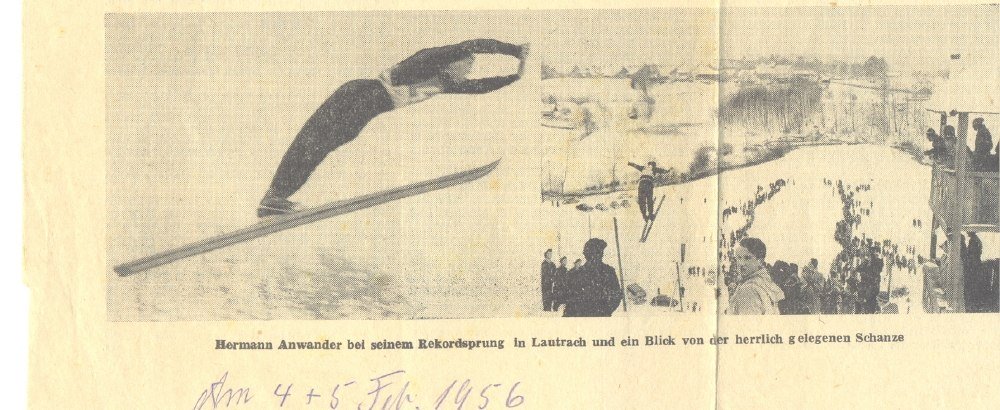Brutscher, Klopfer and Weiler's favourite ski jump
It is the 26th of December, 1952: Christmas jumping on the Kirchbergschanze in Lautrach, Unterallgäu is about to begin. Toni Brutscher, an Olympic athlete from Oberstdorf, had been very impressed by the newly rebuilt ski jump at the official opening event in November and "spoke very highly of it", according to a report in the local paper, the Allgäuer Zeitung, from 24 December, 1952. "We can now also thank him for the fact that famous ski jumpers from the Upper Allgäu will be jumping in Lautrach on Boxing Day, following the many invitations the jumping elite received to various ski resorts in the Allgäu and Upper Bavaria this Christmas," it continues.
His call was answered by other sports legends from Oberstdorf, such as the German ski jumping champion at the time, Sepp Weiler, as well as Heini Klopfer. What was it that made the newly rebuilt ski jump so popular? Could it be the potential for longer jumps? This would be a logical assumption. The report goes on to say: "The TSV Lautrach has extended the Kirchbergschanze even further in recent months, meaning that jumps over 50 metres will now be possible."
In the end, 3,000 spectators watched Lautrach's Christmas jumping live on location. This was a large audience by the standards of the time, as there was only room for about 100 people around the ski jump's out-run. What's more, there were only about 300 people living in Lautrach back in 1952.
Sepp Weiler versus Heini Klopfer - but Max Bolkart also triumphs
It was a thrilling head-to-head jump between Sepp Weiler and Heini Klopfer: Weiler won, even though Klopfer jumped further. "Posture-wise, however, he dipped slightly with 228 points compared to Sepp, who jumped in beautiful posture and achieved a score of 232.6 points," according to the report. Hans Seidel came third and "an excellent performance was achieved by the youngster Max Bolkart-Oberstdorf, who came fourth overall with 42/40 and a score of 218.1."
Heini Klopfer is also the architect of the Lautrach Ski Jump
Ski jumper Heini Klopfer also served as architect for the Kirchbergschanze. He planned the renovation of the ski jump in the autumn of 1952. The in-run was extended and improved with the addition of a tower so the landing and out-run needed to be modified as a result.
Then a site inspection at the beginning of November 1952 threw up a problem: "The ski jump was still 'in a dismal half-finished state'". The head of the TSV Lautrach at the time was not prepared to accept this. "Thanks to the initiative and organisational skills of (...) Dr. Heini Suiter, the impossible was made possible after all, and dedicated men from the club completed the impressive structure on schedule."
Allgäu Nordic Championships in Lautrach, run by Olympic athlete Ludwig Böck from Nesselwang
The Allgäu Nordic Ski Championships were held in Lautrach on 4 and 5 February, 1956. This location was primarily selected due to the lively club activity of the TSV Lautrach. At this event, Hermann Anwander managed to "push the ski jump record to 47 metres." Olympic athlete Ludwig Böck from Nesselwang was in charge of the organisation, competition and arbitration at the Allgäu Nordic Ski Championships. The Sportheim Böck restaurant and lodge on the Alpspitze above Nesselwang in Ostallgäu is still named after him today. Böck built the chalet in 1933 so that as many visitors as possible could learn to ski. Max Bolkart, the multiple German champion from Oberstdorf, also liked to travel to the ski jump in Lautrach for competitions.
Lautrach: Floodlit ski jump popular with top athletes
Bolkart won the night jumping competition on the Kirchbergschanze in 1961. The floodlighting was probably what made the hill so attractive to athletes - being the northernmost ski jump with permanent floodlighting.
Years later: A landslide renders the ski jump inoperable
Many sporting events followed over the years until, on 20 August, 1965, it was announced for the first time "that the ski jump had been rendered inoperable by a landslide in the landing area". The renovation work dragged on until, two years after the landslide, the chairman of the club expressed his first doubts as to whether it was even worth repairing the jump. He was overruled, the ski jump was renovated and in 1969 a night jumping event was held to mark the reopening. But only two years later, another landslide hit the slope. According to the chronicle, "well springs on the loamy slope" were the cause and the ski jump was out of action once again. Neither the club nor the Bavarian Ski Association was able to cover the repair costs of about 100,000 Deutschmarks. Due to poor snow conditions in recent winters that had prevented jumping and led to a drop in active membership within the club, it was finally decided in 1976 that "the ski jump together with the in-run and judge's tower (should) remain in place for the time being, with the necessary safety and barrier measures". The ski jump was finally abandoned in the 1980s. Today, no traces remain of what was once such a popular sports facility on the Kirchberg. Adelbert Kern's chronicle ends with the statement that the former out-run "now serves as a car park for a modern sports ground".
Source: Chronicle - Adelbert Kern, in the archives of the Mayr & Abel printing company, Legau
Further Information: http://www.skisprungschanzen.com/DE/Schanzen/GER-Deutschland/BY-Bayern/
